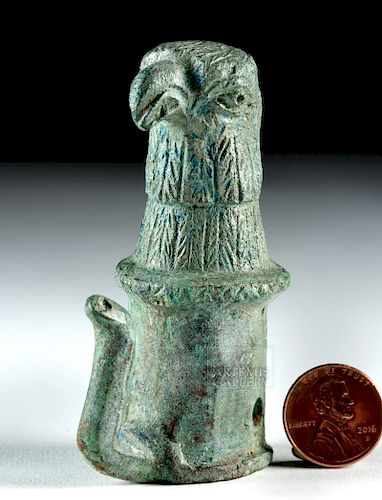Roman Bronze Eagle Chariot Rein Guide
Lot 57b
About Seller
Artemis Fine Arts
686 S Taylor Ave, Ste 106
Louisville, CO 80027
United States
Selling antiquities, ancient and ethnographic art online since 1993, Artemis Gallery specializes in Classical Antiquities (Egyptian, Greek, Roman, Near Eastern), Asian, Pre-Columbian, African / Tribal / Oceanographic art. Our extensive inventory includes pottery, stone, metal, wood, glass and textil...Read more
Estimate:
$1,000 - $1,500
Absentee vs Live bid
Two ways to bid:
- Leave a max absentee bid and the platform will bid on your behalf up to your maximum bid during the live auction.
- Bid live during the auction and your bids will be submitted real-time to the auctioneer.
Bid Increments
| Price | Bid Increment |
|---|---|
| $0 | $25 |
| $300 | $50 |
| $1,000 | $100 |
| $2,000 | $250 |
| $5,000 | $500 |
| $10,000 | $1,000 |
| $20,000 | $2,500 |
| $50,000 | $5,000 |
| $100,000 | $10,000 |
| $200,000 | $20,000 |
About Auction
By Artemis Fine Arts
Feb 6, 2019
Set Reminder
2019-02-06 10:00:00
2019-02-06 10:00:00
America/New_York
Bidsquare
Bidsquare : Ancient | Ethnographic | Fine Art
https://www.bidsquare.com/auctions/artemis-gallery/ancient-ethnographic-fine-art-3848
Featuring classical antiquities, ancient and ethnographic art from cultures encompassing the globe. Artemis Fine Arts info@artemisfinearts.com
Featuring classical antiquities, ancient and ethnographic art from cultures encompassing the globe. Artemis Fine Arts info@artemisfinearts.com
- Lot Description
Roman, Imperial Period, ca. 2nd to 4th century CE. A gorgeous miniature cast-bronze chariot fitting with a slender snake head projecting upwards towards a majestic stylized eagle head atop a columnar shaft. The base and the shoulder of the shaft are ringed and the base has a singular drilled hole. The eagle has a dense pattern of feathers on its head and neck, a deeply-curved beak, and almond-shaped eyes with slit-form openings. Covered in layers of green, blue-green, russet, and azurite patina, this is an elegant example from the Roman Empire! Size: 1.2" W x 3" H (3 cm x 7.6 cm).
Roman chariots were not used for warfare, but instead in circuses and in triumphal processions. As a result, elaborate attachments like this - but of a larger size - became de rigeur, lending a unique look to each chariot, where they were mounted on posts above each wheel. The carriage was supported by leather straps wrapped around the shaft and guided by the projecting arms. This absorbed the vibrations of the wooden wheels, making the ride smoother. Imagine the sun flashing off of the dark, polished bronze that this would have had when made!
The eagle was a highly-symbolic animal among the Roman military and was a great symbol of pride and victory in the eyes of the legions. Known as "aquila" in Latin, the eagle was a representation of honor, victory, and cohesiveness within a legion. One member of each legion was referred to as an aquilifer, or "eagle-bearer," as it was their primary duty to carry and protect that legion's designated eagle standard. If ever an aquila was lost or stolen, it was the primary obligation of the aquilifer to go to any lengths to recover the standard and see to its safe return. Losing an eagle standard was considered a grave omen for its respective legion and would typically lead to distrust and paranoia among the legionaries. To quote a piece of historical fiction set in Roman Britain entitled The Eagle of the Ninth (Rosemary Sutcliff, 1954), "Eagle lost, honor lost; honor lost, all lost."
Provenance: private East Coast, USA collection
All items legal to buy/sell under U.S. Statute covering cultural patrimony Code 2600, CHAPTER 14, and are guaranteed to be as described or your money back.
A Certificate of Authenticity will accompany all winning bids.
We ship worldwide and handle all shipping in-house for your convenience.
#141910Minor nicks and abrasions to base, eagle head, and snake, with softening to some finer details, otherwise intact and excellent. Light earthen deposits and beautiful patina throughout.Condition
- Shipping Info
-
All shipping is handled in-house for your convenience. Your invoice from Artemis Gallery will include shipping calculation instructions. If in doubt, please inquire BEFORE bidding for estimated shipping costs for individual items.
-
- Buyer's Premium



 EUR
EUR CAD
CAD AUD
AUD GBP
GBP MXN
MXN HKD
HKD CNY
CNY MYR
MYR SEK
SEK SGD
SGD CHF
CHF THB
THB















